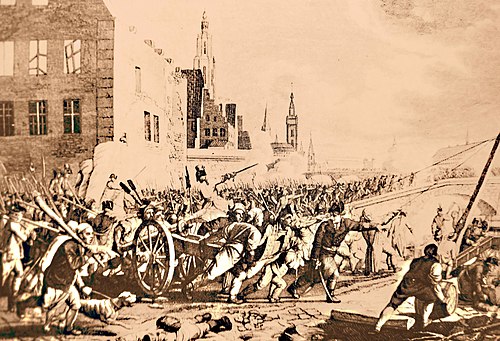United Belgian States | |||||||||
|---|---|---|---|---|---|---|---|---|---|
| 1790 | |||||||||
 The United Belgian States' territory in 1790 | |||||||||
| Status | Unrecognized state Vassal state ofHoly Roman Empire | ||||||||
| Capital | Brussels | ||||||||
| Government | Confederalrepublic | ||||||||
| President of the Sovereign Congress | |||||||||
• 1790 | François de Nélis | ||||||||
• 1790 | Henri de Crumpipen[1] | ||||||||
| President of the National Congress | |||||||||
• 1790 | Henri Van der Noot | ||||||||
| Legislature | Sovereign Congress | ||||||||
| Historical era | Brabant Revolution | ||||||||
| 24 October 1789 | |||||||||
| 11 January 1790 | |||||||||
| 22 September 1790 | |||||||||
• Surrender of Brussels | 2 December 1790 | ||||||||
| Currency | SeeBrabant Revolution coinage | ||||||||
| ISO 3166 code | BE | ||||||||
| |||||||||
| Today part of | |||||||||
TheUnited Belgian States (Dutch:Verenigde Nederlandse Staten orVerenigde Belgische Staten;French:États-Belgiques-Unis), also known as theUnited States of Belgium, was a short-livedconfederalrepublic in theSouthern Netherlands (modern-dayBelgium) established under theBrabant Revolution. It existed from January to December 1790 as part of the unsuccessful revolt against theHabsburg Emperor,Joseph II.
United Belgian States' area coincided between 1789 and 1790 with the western and central part of present-dayBelgium. Before that, it corresponded to the largest part of theAustrian Netherlands, that is to say, regions within theHoly Roman Empire ruled by the Austrian Habsburgs.
Influenced by theEnlightenment, Emperor Joseph II, who became sole ruler of theHabsburg lands afterMaria Theresa's death in 1780, decreed a series of large-scale reforms in theAustrian Netherlands designed to radically modernize and centralize the political, judicial and administrative systems.
Characteristically, Joseph II abruptly imposed his reforms without even a semblance of consultation with the population, which actually included an influential urban intelligentsia and other segments of the ruling classes who were highly receptive to such innovations. The Emperor'sedict of tolerance of 1781 established religious freedom. Another edict in 1784 removed from the Catholic clergy responsibility for the civil registry, and civil marriage was introduced. Under theEdict on Idle Institutions (1780), contemplative religious orders, deemed useless, were dissolved and diocesan seminaries were abolished and replaced by general seminaries inLeuven and Luxembourg. Feudal and trade corporation regulations and jurisdictions were modified or abolished, and the authorities abolished the ancient provinces ofFlanders,Brabant,Hainaut,Namur, andLuxembourg, replacing them with 9 circles (German:Kreise), subdivided in 64 districts. Seigneurial jurisdictions and rights, including thecorvée, were abolished.[2][full citation needed] As inHungary, Joseph II attempted to introduceGerman as the language of administration for the sake of efficiency.
The United Belgian States was aconfederalrepublic of eightprovinces which had their own governments, weresovereign andindependent, and were governed directly by theSovereign Congress (French:Congrès souverain; Dutch:Soevereine Congres), the confederal government. The Sovereign Congress was seated inBrussels and consisted of representatives of each of the eight provinces.Henri Van der Noot served in the capacity ofHead of government,[3][4] retaining the title ofminister plenipotentiary having previously held the title of minister plenipotentiary of Brabant (Ministre Plénipotentiaire du Brabant).[5]




In 1789, a church-inspired popular revolt broke out in reaction to the Emperor's centralizing and anticlerical policies. Two factions appeared: theStatists who opposed the reforms, and theVonckists named forJan Frans Vonck who initially supported the reforms but then joined the opposition, due to the clumsy way in which the reforms were carried out.
The uprising started inBrabant, which in January 1789 declared that it no longer recognized the Emperor's rule. The leader of the Statisten faction,Henri Van der Noot, crossed the border into theDutch Republic and raised a small army inBreda inStaats-Brabant, the northern (Dutch Republic) part of Brabant.
In October, he invaded Brabant and capturedTurnhout, defeating the Austrians in theBattle of Turnhout on 27 October.Ghent was taken on 13 November, and on 17 November thegovernorsAlbert Casimir andMaria Christina fledBrussels. The remains of theimperial forces withdrew behind the citadel walls ofLuxembourg andAntwerp.
Van der Noot now declared Brabant independent, and all the other provinces of the Austrian Netherlands (exceptLuxembourg) soon followed suit. On 11 January 1790 they signed a pact, establishing a confederation under the nameVerenigde Nederlandse Staten /États-Belgiques-Unis (United Belgian States) and a governing body known as theSovereign Congress. The DutchAct of Abjuration in 1581 and the AmericanDeclaration of Independence in 1776 served[6] as models for the Declaration of Independence of Flanders and some of the other provinces between November 1789 and early 1790. Shortly afterwards, the Articles of Confederation served as a model for theTreaty of the United Belgian States of 11 January 1790.
Independently, in 1789, arevolution had broken out inLiège. The revolutionariesestablished a republic which joined the United Belgian States in a semblance of an alliance.
Realizing the fragility of the new state, Van der Noot approached foreign states for support and suggested a unification with the Dutch Republic, with little success. Furthermore, theStatist andVonckist factions were in constant conflict, bordering on civil war.
On 27 February 1790Joseph II died and his brotherLeopold II succeeded him as emperor. Leopold II quickly moved to recapture the Austrian Netherlands. On 24 October 1790 imperial troops took the city ofNamur, forcing the province ofNamur to recognize the authority of the Emperor. Two days later, the province ofWest Flanders followed suit, and by December the entire territory was again in imperial hands.
The Austrian restoration and hegemony was historically brief however, as the region was overrun by theFrench Revolutionary Army in 1794 during theFrench Revolutionary Wars, and was annexed byFrance on 1 October 1795.
Though short-lived, the United Belgian States had long-lasting repercussions. It had given theSouthern Netherlands their first taste ofindependence, and had sparked a new political idea: the state ofBelgium. In 1830, the inhabitants of the Southern Netherlands successfully revolted against theNetherlands during theBelgian Revolution, creating the modern state of Belgium.